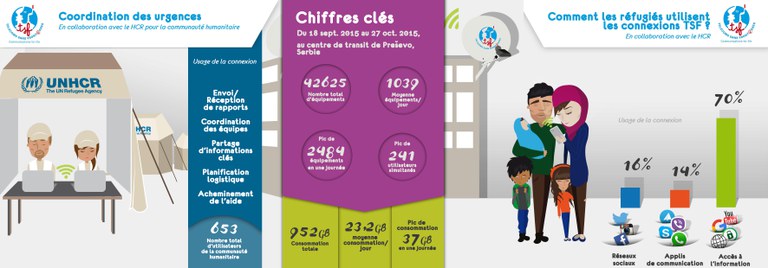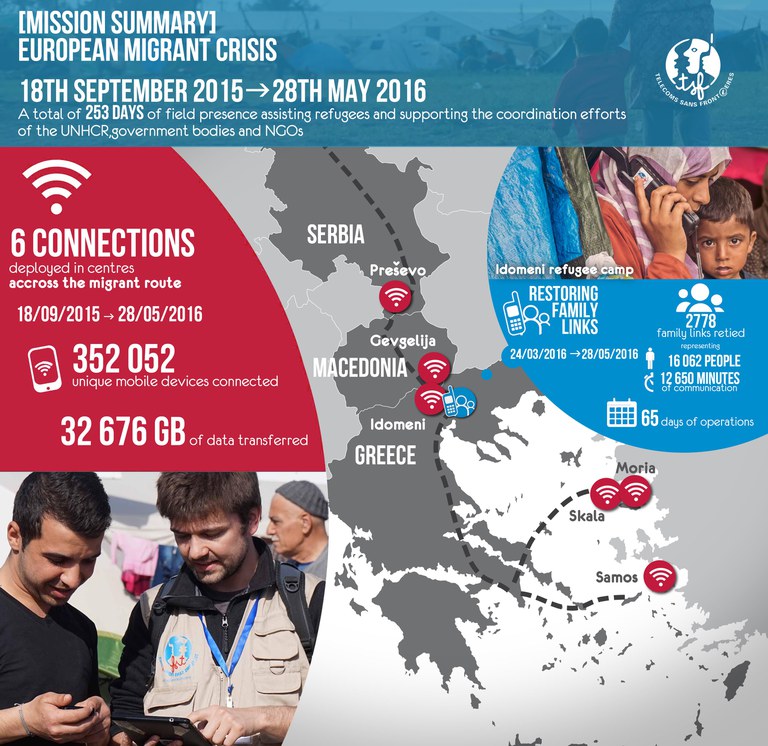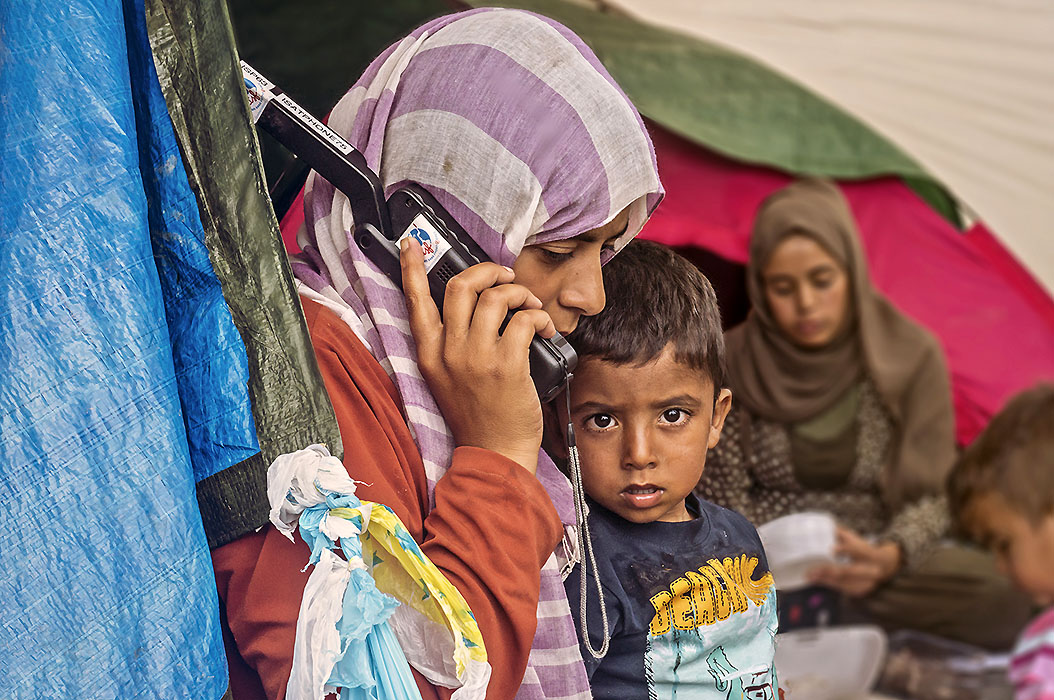European Migrant Crisis
Context: Population displacement
Start date: 18/09/2015
End date: 28/05/2016
Areas of intervention:
- Preševo camp, Serbia
- Gevgelija camp, Macedonia
- Idomeni camp, Skala and Moria camps in Lesbos, Greece
Activities:
- Connectivity for population
- Humanitarian calling operations
- Support to coordination
- Information diffusion
6 transit centres connected to the Internet
32,696 GB of data transferred
325,302 unique devices connected
12,650 minutes of calls
2,778 families benefitting from calling operations
Context
Throughout 2015, the ongoing conflicts in Syria, Iraq and other countries across the globe brought about the displacement of unprecedented numbers of refugees and migrants in Europe. The western Mediterranean and western Balkan routes were the principal transit zones for thousands of families who would arrive on the Greek Islands, then travel up though Macedonia, Serbia, Croatia, Hungary, Slovenia and Austria.
For these transit countries, the management of migratory influx signified several complex challenges: difficulties in coordination, overburdened transit centres, a high number of non-accompanied minors and extreme weather conditions.
Faced with the continuous arrival of migrants in the Balkans, more and more countries started to tighten entry conditions up until the total closure of borders along the Route on 8th March 2016.
With the majority of families having travelled in the most challenging of conditions, their mobile phone represented a veritable lifeline, their only way of communicating with the world that they had been forced to abandon, and those they may have lost during the journey. Although the majority of people owned a smartphone, the lack of access to Internet, and therefore the lack of access to information, rapidly became an issue.
Faced with this situation, Télécoms Sans Frontières intervened at the heart of the crisis to provide internet access along the route.
Connectivity for populations
In September 2015, a first satellite internet connection was installed by TSF in the Preševo One-Stop Centre in Serbia, where a vast majority of refugees passed along their route. TSF then developed a technical solution capable of supporting several hundred mobiles simultaneously connected to a Wi-Fi connection.
As winter approached, the influx of families intensified, despite the saturation of the route’s camps. Many families remains stranded on the Aegean islands, with several people separated from their loved ones.
Faced with the increase in the number of arrivals, TSF extended its activities from October 2015 onwards, covering the principal points of passage on the Greek Islands (Lesbos and Samos), mainland Greece and Macedonia. All connections were installed at mandatory transit centres, meaning that families could benefit regularly from TSF unlimited Wi-Fi throughout their route.
TSF recorded that one mobile device often served two or more people according to the size of the family or group. In total, the 325,302 unique devices connected to TSF Wi-Fi allowed more than 600,000 people to remain in touch with their loved ones.
The European Migrant Crises demonstrated an evolution in the importance of the smartphone during a humanitarian crisis, and the way in which this tool can impact the day-to-day lives of migrant families.
For the first time in its operations, TSF was able to empower hundreds of thousands of beneficiaries by giving them the opportunity to use their own tools to respond to their personal requirements. TSF high-density Wi-Fi connections acted as a powerful catalyst for helping maintain family ties (via social networks or instant messaging, for example), and access vital information online.

Humanitarian calling operations
Idomeni camp
Idomeni (Greece) was originally a transit camp at the border between Greece and Macedonia. Following border closure measures, more than 10,000 people found themselves stranded at the gates of Macedonia. But the camp's capacity was insufficient to accommodate them in good conditions and conditions quickly became unsanitary.
In addition to the connectivity throughout the migration route, TSF also carried out calling operations in Idomeni for 65 days until the dismantlement of the camp, allowing those without any means of communication to contact their families abroad or from whom they had been separated.
2,778 such families (representing a total of 16,062 people) were able to benefit from 12,650 minutes of calls, mostly to Syria, Iraq and Afghanistan. The majority of these families had not been in touch with their loved ones for weeks, and in many cases, several months.
Preševo
Within the framework of its commitment to helping restore family ties, TSF supported the Red Cross of Serbia in its programme that aims to bring back together families lost along the route. Thanks to the support of TSF, the Red Cross was able to facilitate access to and extend its online platform to reunite families that had been separated in the Balkans.
Support to humanitarian coordination
Internet access was also made available to the humanitarian community working along the route in Greece, Macedonia and Serbia. With the daily arrival of several thousand families in registration centres, the government and non-government agencies on the ground required a means for improving the circulation of information between countries, logistics and conveyance of aid items.
Thanks to internet access, several hundred humanitarian and government workers were able to reinforce coordination whilst improving the care and support brought to migrant families.
This connectivity was maintained in Serbia and Macedonia until the end of April 2016 thanks to co-funding provided by the United Nations Refugee Agency (UNHCR).
Information diffusion for migrants
In registration and transit centres, families often found themselves faced with complex situations caused by unfamiliar administrative and registration procedures (forms to fill out, identity papers to prepare, etc.). This context caused waiting times ranging from several hours to several days, in particular in Preševo, Serbia.
In order to facilitate the registration process, TSF developed an information diffusion solution consisting of a system of microcomputers connected to a network and to a server. This system was connected to screens positioned in the strategic locations of the registration centres.
The information diffused on the screens (in several different languages) helped to better inform migrants about the administrative procedures, the services available, and the steps to follow to prevent them from being victimised by the trafficking networks. Many migrants were smuggled by clandestine networks that would intentionally send them to the wrong places. This diffusion of information thus made it possible to improve people’s safety by guiding them upon arrival in the centre.






























